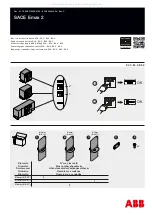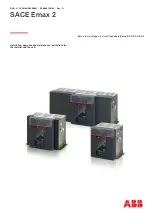
FIG.
88
TEST SET, CAT. NO. TVTS1
1 2.4.1 RESISTANCE VALUES
For use in troubleshooting the MicroVersaTrip ....
current sensors, the resistance of the tapped and fixed
windings is given in Tables 1 3 and 1 4 respectively.
TABLE 1 3 - TAPPED SENSOR RESISTANCE
VALUES
Resistance in Ohms
Ampere
Between Common
Tap
and Tap Terminals
1 00
7.0-8.2
1 50
10-12
225
15-18
300
20-24
300
20-24
400
27-32
600
42·50
800
58-68
600
42·50
800
53-68
1 200
93-1 09
1 600
1 30-154
800
74·88
1 200
1 16-136
1 600
162·190
2000
210-246
TABLE
1 4 -
FIXED SENSOR RESISTANCE
VALUES
Ampere
Rating
1
0
0
1 50
225
300
400
600
800
1 200
1 600
2000
Resistance In
Ohms
Between Terminals
6
7-7.8
10-12
15-17
20-24
27-32
42-50
58-68
92-108
1 29-151
207-243
The coil resistance of the MlcroVersaTrlp flux shifter
device Is approximately
7
ohms.
SECTION 1 2-MicroVersaTrip ™
Trip Device (Cont.)
1 2.4.2 FALSE TRIPPING-BREAKERS
EQUIPPED WITH G ROUND FAULT
When nuisance tripping occurs on breakers equipped
with the G round Fault trip element, a probable cause is
the existence of a false "ground" signal. As indicated by
the cabling diagram of Fig. 90, each phase sensor is
connected to summing circuitry in the programmer. U n
der no-fault conditions on 3-wire load circuits, the
currents in this circuitry add to zero and no gro�.md
signal is developed. This current sum will be zero only if
all three sensors have the same electrical charac
teristics. If one sensor differs from the others (i.e., dif
ferent rating or wrong tap setting), the circuitry can
produce output sufficient to trip the breaker. Similarly,
discontinuity between any sensor and the programmer
unit can cause a false trip signal.
If nuisance tripping is encountered on any breaker
whose MicroVersaTrip components have previously
demonstrated satisfactory performance via the TVTS1
Test Set, the sensors and their connections should be
closely scrutinized. After disconnecting the breaker from
all power sources.
a) Check that all phase sensors are the same type (am
pere range).
b) Ensure that the tap settings on all 3-phase sensors
are identical.
c) Verify that the harness connections to the sensors
meet the polarity constraints indicated by the cabling
diagram.
d) On G round Fault breakers serving 4-wire loads,
check that the neutral sensor is properly connected (see
cabling diagram Fig. 9 1 ) . In particular,
( 1 ) Verify that the neutral sensor has the same rating
and tap setting as the phase sensors.
(2) Check continuity between the neutral sensor and its
equipment-mounted secondary disconnect block. Also
check for continuity from the breaker-mounted neutral
secondary disconnect block through to the female harness
connector.
(3) If The breaker's lower studs connect to the supply
source, then the neutral sensor must have Its LOAD end
connected to the source. See Fig. 92.
(4) Ensure that the neutral conductor is carrying only
that neutral current associated with the breaker's load cur
rent (neutral not shared with other loads).
e) If the preceding steps fail to identify the problem, then
the sensor resistances should be measured. Since the
phase and neutral sensors are electrically identical, their
tap-to-tap resistances should closely agree. See Tables 1 3
and 14.
65
www
. ElectricalPartManuals
. com









































